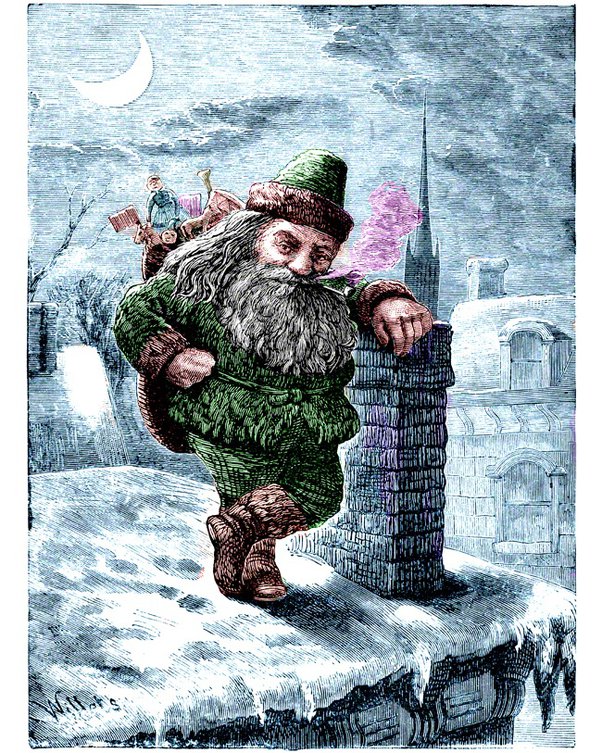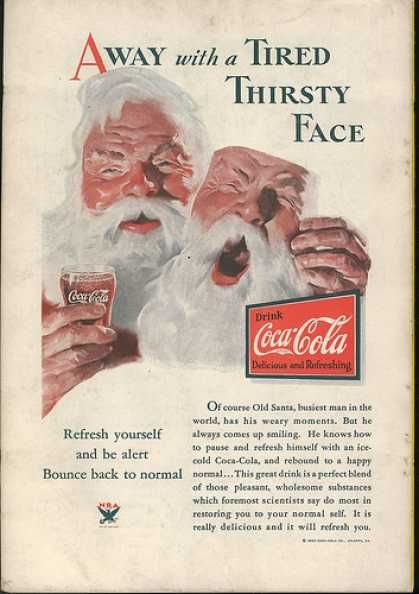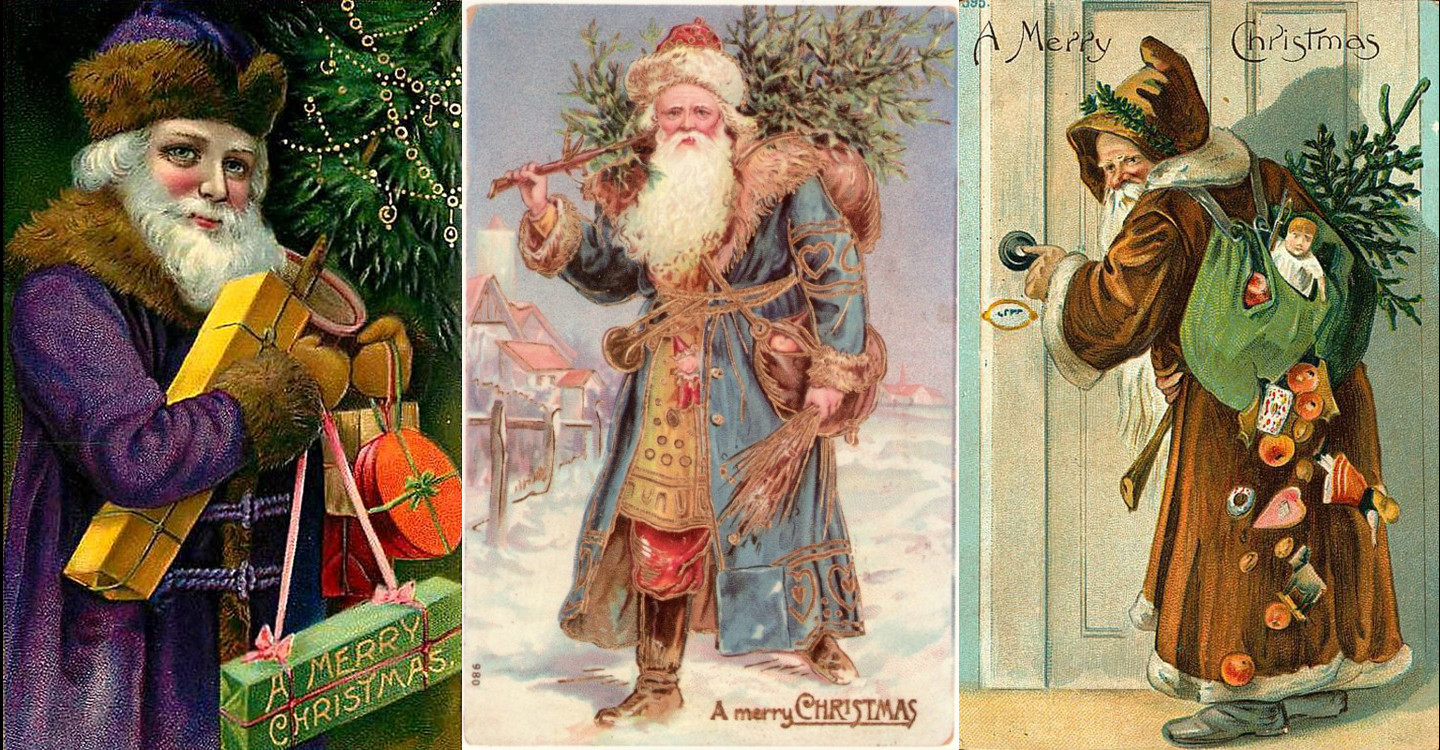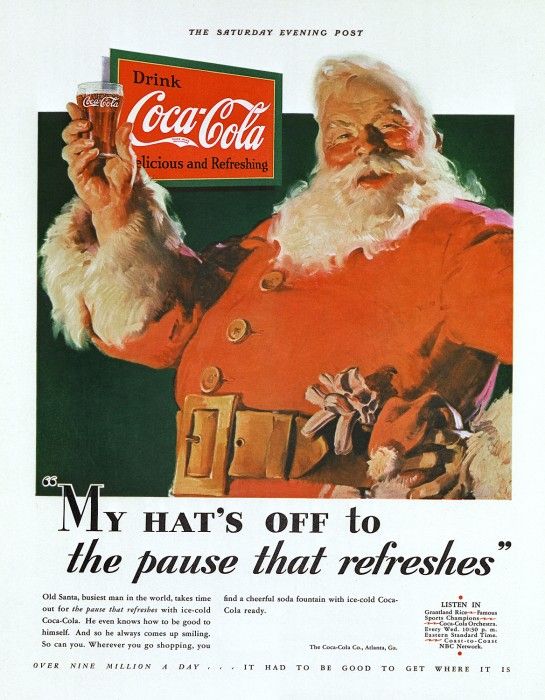
Did Coca-Cola Invent Santa Claus and Shaped our Christmas? (7 min read)
Coca-Cola has used the image of Santa Claus to advertise during holidays for more than 80 years. They weren’t the first, nor the only ones, but their image of Santa is how the old man is pictured around the globe today.

Coca-Cola Santa Claus History Timeline
- 1820s – first ads for Christmas presents appear in the US
- 1840s – marketers notice that Santa Claus as a personification of Christmas can be used to sell goods
- 1920s – Coca-Cola uses Santa Claus in an ad for the first time
- 1923 – red becomes the color of the company
- 1931 – an illustrator named Haddon Sundblom paints Santa Claus as a plump, warm, and friendly human with red cheeks, red and white robe, and boots. It’s the third approach at depicting Santa Claus by Coca-Cola. This image is used on store displays, billboards, posters, calendars and plush dolls and stays with the company for ever.
- 1930s-1960s – Mass advertising begins, portraying Christmas as an opportunity to make your family happy with presents. Coca-Cola also rides on this wave, becoming a globally recognized brand in the meantime.
- 1963 – Sundblom makes the last Santa painting for Coca-Cola
- 1996 – Coca-Cola introduces pre-wrapped bottles as christmas gifts with the original Sundblom imagery
- 1998 – a new truck-based ad, ‘Christmas Caravan III’ is broadcasted to 100 countries, getting millions of views
- 2001 - the 1963 Coke’s Santa gets animated in a TV commercial, real Christmas trucks go on the road to visit communities, so the ad resonates more with their members
- 2020 – Christmas-related Coca Cola ads are still the most acclaimed and provide the best results across the industry

The history of Christmas - Christmas is a commercial event. At least partially
Christmas wasn’t popular in the US in the 17th and 18th century. It was either banned or just an occasion to get drunk. The traditional Christmas as a family event has been brought here by Germans and Britons along with the aspect of giving presents, but it wasn’t widely celebrated.
Over the decades, Christmas rose in popularity thanks to… advertising! Businesses have noticed the opportunity in a holiday of giving presents. That means Coca-Cola has had its influence on how we are celebrating Christmas today. So in a way you could say Coca-Cola shaped the Christmas we have right now.

The Coca-Cola company’s growth increased its influence around the globe
Coca-Cola is well known for its creative marketing that gets remembered through sparking emotions. That’s not only limited to their festive advertising but their all-year-round activities. Today, Coca-Cola spends as much as $4B (billions!) per year on advertising. It’s one of the most powerful brands out there.
That’s to the long advertising tradition. The first Coca-Cola text ad appeared in the Atlanta Journal in 1886. Since then, Coca-Cola ads have been everywhere, changing the copywriting and creatives together with everything else around. It became an ‘American thing’ and as the US rose to become the world’s power, so did its culture influence on other regions.

Creativity means awareness
You don’t have to design and shape the surrounding reality to market your products. You can look around and adapt the reality as well. No matter if that was really on purpose or more through a number of unlinked decisions, Santa Claus became a seasonal brand hero of Coca-Cola.
So did Coca-Cola invent Santa Claus? He was already there, they just needed to pick the right portrait from a set of styles. Santa filled the brand’s purpose to share joy perfectly. He also wore the brand’s colors. He was the perfect fit even before anyone in the advertising had noticed it!
It required some awareness and creativity to find the connection and use it to build the brand.

Branding Santa
The true origin of red and white colors of Santa Claus is not known. He was rather dressed in fur, brown or green, but some portraits from his life before Coca-Cola’s period seen hem in red and white. Coca-Cola hadn’t always been red and white. Actually, Coca-Cola colours was chosen after their Santa wore them.
That’s the origin, but the true power lies in the consistency. Once Coca-Cola rebranded to red and white, they kept the colors for over half a century. Along all these decades, Santa Claus had also been used as the seasonal brand hero. Eventually, the connotations became deeply engraved in the society, especially after World War II was won by allies, when so many countries were looking at the US and Coca-Cola being one of the most American things on export.


No Banner Blindness
Today, ads are mostly intrusive. That wasn’t the case in the 20s, 30s, and during the golden age of advertising depicted in Mad Men. Before humans developed their brains and eyes to ignore display ads, they were looking at them carefully. They read every single word and looked at every picture detail.
That worked so well for building a brand to last for decades. When the ads showed kids leaving Coke for Santa, kids started doing it, too. When one time the illustrator didn’t paint the wedding ring, people sent letters asking what happened to Mrs. Claus. There was another time when Santa had his belt painted in the opposite direction. That was probably due to the fact that the illustrator was using his reflection as a model–which didn’t go unnoticed by the fans.
Imagine having such an audience today!
The Herd Behavior
People tend to behave based on herd mentality on a daily basis. That was also one of the factors that engraved Coca-Cola’s vision of Santa Claus in pop culture. Coca-Cola’s advertising budgets ensured wide, global reach while others–artists and smaller businesses–chose to follow their style if it was successful for such a global brand.
Over the last hundred years, you could see thousands of Santa Claus portraits that followed the same patterns. With Coca-Cola’s Santa ads taking over during the winter season, that all contributed to making their brand story even more powerful.


So in fact Coca-Cola did invent Santa in a way. Very few brands have had such an impact on the culture as Coca-Cola. As advertisers, we mustn’t forget that it’s also a way of investment–and it could be a long term investment, too.
Coca-Cola had nothing to do with Christmas, but investing in Santa Claus ads during their brand development phase and following the decision consistently over years and decades have built associations that might last as well forever–with the help of producing great ads that spark emotions each year.
What’s in it for you? Look around and be creative. Maintain the performance and be consistent with your messaging. If that doesn’t work from day 1, it might be a long term investment that will pay off greater later on.
Get your
"oh sh*t, this might work for us!"
moment in the next 5 minutes
Viral marketing case studies and marketing psychology principles that made hundreds of millions in months or weeks
In the first email:
- a step-by-step strategy that made $0-$30M within 9 weeks with $0 marketing budget (case study)
- cheatsheet (PDF) of 10 biases in marketing used by top 2% companies
Other than that:
- weekly original content that helps you STAND OUT by providing more perceived value with less work

(You won't find it anywhere else)

Explore Cognitive Biases in Marketing